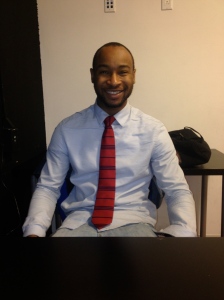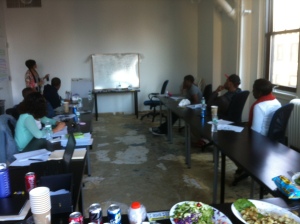This question has occupied my mind for the whole of my professional life. Most recently, I have worked as a program coordinator for New York City non-profits, and previously, I worked as a program advisor and workshop facilitator at the University of California at Berkeley. I grapple with these questions daily: “How do we really find work we love?” and “How do we earn a living offering this work?” For me, this is a manifestation of a larger life question that is increasingly important to me: how do we live lives that we truly love, and teach our young adults to do the same? In Ysette’s recent article on working on dream jobs now, she shares the importance of taking tangible steps towards a passion. While I agree with the significance of taking small steps towards a large goal, I wonder how we can lay out a complete map for our young adults to understand the short and long term processes of pursuing passions and earning a living.
The population I serve are mostly young adults of color, ages 19-24, who span a range of educational and socio-economic backgrounds. When I think of my own career aspirations, I pursued this work with an interest in supporting young adults in making conscious choices towards their dreams in both career and in life. With this in mind, I have contemplated, from a service provider standpoint, what is my responsibility in offering programming and guidance to assist young adults in finding work they love? And, how do our young adults identify their dreams in career and life, and actively take steps to make this happen?
Embedded in these questions are the assumptions that one we can earn a living off of the dreams that they have, that our dreams are truly what we want, that our dreams are the roots of a fulfilling life, and that all we need is to have a dream, take the steps, and it will be realized. I am questioning these assumptions, and considering the flaws that exist within them. In order to assist you in understanding my own process, I invite you to contemplate the following themes and questions:
WORKPLACE CULTURES
1. What are the workplace cultures that we were taught, that we currently work in, and that we reinforce (consciously and unconsciously) to our young adults? How does this impact the conversation around dream careers and lives?
DREAM LIFE COMPONENTS
2. What makes a “dream” life and is this something that is reserved for young adults with more privileged backgrounds (racially, economically, socially)?
3. What is an inspired and rational process of supporting the assessment of the multitude of areas one could consider when choosing a dream career and life?
4. What qualifies as a “dream” career and life? Are there certain dreams that are more sustainable and/or more authentic than others?
FAMILY AND COMMUNITY INFLUENCE
5. What role does family play in our young adults pursuits of larger dreams? In particular, if our young adults can or cannot lean emotionally and financially on family, will they be better or ill suited to choosing dream careers?
6. Who were/are our models for choosing a career, who are our young adults’ models, and who will we connect to our participants to support their pursuit of their dream lives?
7. Where do we find diverse voices of professionals to mentor our young adults through the process of choosing and crafting dream lives?
REALISTIC EXPECTATIONS
8. When we support the exploration and pursuit of dream lives, how do we also teach responsibility and basic survival skills? How can both reality and idealism exist in the exploration and implementation processes?
9. How do we speak to both the significance of our young people dreaming big, but also being grounded in reality of their actual skills, strengths, and abilities?
10. How do we factor in income and wealth into our decisions? Specifically, when our young adults contemplate choosing dream careers, how do we support them in factoring in expected earning potential, prestige and societal perceptions?
11. What role does labor market research and understanding larger societal structures play in assisting young adults in assessing pathways and probability of dream lives?
EDUCATION AND TRAINING
12. How does post-secondary education assist and harm the process of choosing dream careers? In particular how do college curricula speak to, and not speak to, our young adults’ dreams? How does post secondary education influence young adults financial health, specifically through the acquisition of student and private loan debt?
PRACTITIONER BIASES
13. How do we reflect on our own process of choosing careers as professionals? How do our passions, mistakes, shortcomings and assumptions negatively, and positively, influence the outlook of our young adults? How do our biases as service practitioners influence our young adults’ process?
It is my intention to further explore these themes over the next few months through this blog. In the meantime and throughout this exploration process, I welcome your sharing and ideas.
—————–

Over the past 10 years, Stephanie has cultivated roles as an advisor and coordinator in both NYC and the San Francisco Bay Area. She has worked within non-profit and university settings in the fields of college success and career development. Stephanie has facilitated, developed and coordinated programming for first generation college students and young adults of color. She earned a BA in Sociology and a MA in Education both from the University of California at Berkeley.



